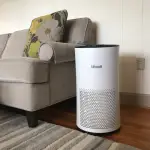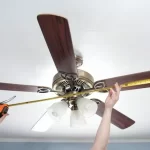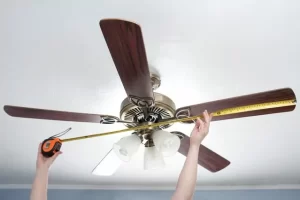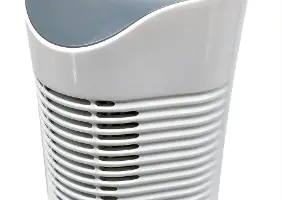Ceiling fans have become an integral part of our lives, offering a refreshing breeze on hot summer days and helping to circulate air in our living spaces. Many of us rely on these trusty companions to keep us cool and comfortable, especially during the scorching months. However, have you ever wondered how long a ceiling fan can run continuously without any adverse effects? Is it safe to leave it on all day and night, or should we be mindful of its operation?
Contents

Last summer, me and my family went for a day out. That day we left the ceiling fan in our bedrooms on accidentally. There was no serious damage anywhere, but the fan motor had slightly heated up. It is then that I researched on how long can a ceiling fan run continuously and is it safe to keep it so? In this article, we will delve into the fascinating world of ceiling fans and explore the factors that determine their continuous operation.
Should You Run Ceiling Fans When Not in Room?
No, it is not advisable to run ceiling fans when you are not in the room. This is primarily due to energy conservation concerns and safety considerations. Running a ceiling fan in an unoccupied room wastes electricity and contributes to higher energy bills. However, if you stay in an area where there are mosquitoes and other flies, you might keep the fan on to avoid them in your bedroom. In a very rare situation, leaving a fan unattended can pose safety risks, such as accidents or damage to items beneath the fan.
Now let us see some factors affecting the continuous operation of the ceiling fan:
Factors Affecting Continuous Operation
There are various factors affecting the continuous operation. Let us see each of them in detail below:
Motor Quality and Durability
- Impact of Motor Quality: The quality of the motor plays a crucial role in determining a ceiling fan’s ability to run continuously. A high-quality motor is designed to handle long hours of operation without overheating or wearing out. It ensures smooth and efficient functioning, reducing the risk of motor failure or breakdown during continuous use.
- Types of Motors and Durability: Ceiling fans generally come with two types of motors: AC (alternating current) and DC (direct current). AC motors are more common and are known for their durability and reliability. They are designed to handle continuous operation for extended periods without experiencing significant wear and tear. On the other hand, DC motors, although more energy-efficient, may have varying durability depending on the manufacturer and model.
Fan Design and Build
- Importance of Fan Design and Build Quality: The design and build quality of a ceiling fan are critical factors in determining its ability to run continuously. A well-designed fan with sturdy construction can withstand continuous operation, minimizing the risk of structural issues or component failure. High-quality materials and precise engineering contribute to the fan’s overall durability and longevity.
- Influence of Blade Material and Construction: The choice of blade material and construction can significantly impact the fan’s lifespan and continuous operation. Blades made from durable materials such as wood, metal, or high-quality plastics tend to last longer and maintain their performance over time. Additionally, the design and shape of the blades, including their pitch and aerodynamics, can affect the fan’s ability to circulate air efficiently and operate smoothly for extended periods.
Maintenance and Care
- Significance of Regular Maintenance: Regular maintenance is crucial for ensuring the continuous operation of a ceiling fan. Over time, dust, dirt, and debris can accumulate on the blades, affecting their balance and performance. Neglecting maintenance can lead to increased friction, noise, and strain on the motor, potentially reducing its lifespan. Regular maintenance helps keep the fan in optimal condition for prolonged use.
- Tips for Proper Fan Maintenance:
- Cleaning: Regularly dust the fan blades using a soft cloth or a vacuum cleaner with a brush attachment. For more thorough cleaning, remove the blades and clean them individually. Avoid using harsh chemicals or excessive moisture during cleaning.
- Lubrication: Lubricate the fan’s bearings or motor as recommended by the manufacturer. This helps reduce friction and ensures smooth operation.
- Tighten Connections: Periodically check and tighten any loose screws or connections to maintain stability and minimize vibrations.
By understanding and considering these factors, such as motor quality, fan design, and maintenance, you can optimize the continuous operation of your ceiling fan and prolong its lifespan.
Leaving Ceiling Fans on While on Vacation
Leaving ceiling fans on while on vacation is generally not necessary and may not be the best choice. Here are some factors to consider:
- Energy Consumption: Ceiling fans consume electricity, and leaving them on for extended periods, especially when not needed, can contribute to unnecessary energy usage and increase your utility bills. To conserve energy and reduce costs, it’s advisable to turn off ceiling fans when you’re away.
- Safety Concerns: Leaving a ceiling fan running unattended raises safety concerns. There is a risk of accidents or damage if items are left unsecured beneath the fan or if the fan malfunctions. Additionally, if you have pets or children who could potentially interact with the fan, it’s crucial to ensure their safety by turning it off when you’re away.
- Climate Control: Ceiling fans primarily provide a cooling effect through air movement. If you’re not present in the space, there is no need for the fan to run as it won’t offer any practical benefit. Instead, focus on adjusting your thermostat or utilizing other methods to maintain an appropriate temperature while you’re on vacation.
- Maintenance Considerations: Running a ceiling fan continuously without periodic rest and maintenance can potentially lead to increased wear and tear. It’s beneficial to allow the fan to rest periodically to ensure its longevity and performance. Additionally, while you’re away, you won’t be able to address any maintenance issues that may arise.
In conclusion, it is generally recommended to turn off ceiling fans while on vacation to conserve energy, reduce safety risks, and allow for proper maintenance. Instead, adjust your thermostat settings appropriately and consider other energy-saving measures to ensure climate control in your absence.
- It is always better to put off the fan when not in use when it comes to saving energy.
- If you are putting it on to avoid issues of mosquitoes and flies, you may keep it on.
- If you are going for a long vacation, you may simply keep the fan on for a while, once all the mosquitoes are out you can close all the doors and windows and put the fan off.
- Keeping the fan on with the idea of cooling the room for long is of no sense.
FAQs on Running Ceiling Fan Continuously
Should you run ceiling fans in the winter?
Running ceiling fans in the winter can still be beneficial. Most ceiling fans have a reverse or winter mode that allows them to operate in a clockwise direction. This helps to circulate warm air that naturally rises to the ceiling, pushing it back down into the room. This can result in better heat distribution and potentially reduce heating costs.
Is it safe to leave fans on all the time?
Leaving fans on all the time can be safe as long as they are in good working condition, properly installed, and used according to the manufacturer’s instructions. However, it’s important to consider the energy consumption and potential safety hazards associated with continuous fan operation, such as electrical issues or accidents involving loose objects or wiring. It’s generally advisable to turn off fans when not needed to conserve energy and reduce the risk of accidents.
Is it okay to leave ceiling fans on all night?
Leaving ceiling fans on all night can be a personal preference, but it’s important to consider factors such as noise levels, energy consumption, and safety. Ceiling fans generally have low noise levels, which may not disturb sleep for some individuals. However, the continuous operation can contribute to increased energy consumption, and it’s advisable to weigh the benefits against energy conservation. Additionally, ensure the fan is in good condition, positioned securely, and there are no safety concerns before leaving it on overnight.
Conclusion on Leaving Fan On When Not in Use
In summary, while personal comfort preferences and specific situations may influence the decision, it is generally more practical and energy-efficient to turn off ceiling fans when not in the room. By being mindful of our usage, we can strike a balance between personal comfort and responsible energy conservation, while also ensuring safety and maintaining the fan’s optimal performance.










Add Comment